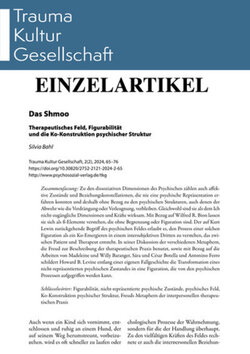12 Seiten, PDF-E-Book
Erschienen: Mai 2024
Bestell-Nr.: 36541
https://doi.org/10.30820/2752-2121-2024-2-65
abonnieren
Silvia Bahl
Das Shmoo (PDF)
Therapeutisches Feld, Figurabilität und die Ko-Konstruktion psychischer Struktur
Sofortdownload
Dies ist ein E-Book. Unsere E-Books sind mit einem personalisierten Wasserzeichen versehen,
jedoch frei von weiteren technischen Schutzmaßnahmen (»DRM«).
Erfahren Sie hier mehr zu den Datei-Formaten.
Zu den dissoziativen Dimensionen des Psychischen zählen auch affektive Zustände und Beziehungskonstellationen, die nie eine psychische Repräsentation erfahren konnten und deshalb ohne Bezug zu den psychischen Strukturen, auch denen der Abwehr wie die Verdrängung oder Verleugnung, verbleiben. Gleichwohl sind sie als dem Ich nicht-zugängliche Dimensionen und Kräfte wirksam. Mit Bezug auf Wilfred R. Bion lassen sie sich als ß-Elemente verstehen, die ohne Begrenzung oder Figuration sind. Der auf Kurt Lewin zurückgehende Begriff des psychischen Feldes erlaubt es, den Prozess einer solchen Figuration als ein Ko-Emergieren in einem intersubjektiven Dritten zu verstehen, das zwischen Patient und Therapeut entsteht. In seiner Diskussion der verschiedenen Metaphern, die Freud zur Beschreibung der therapeutischen Praxis benutzt, sowie mit Bezug auf die Arbeiten von Madeleine und Willy Baranger, Sára und César Botella und Antonino Ferro schildert Howard B. Levine entlang einer eigenen Fallgeschichte die Transformation eines nicht-repräsentierten psychischen Zustandes in eine Figuration, die von den psychischen Prozessen aufgegriffen werden kann.
Abstract:
The dissociative dimensions of the psychic also include affective states and relationship constellations that were never capable of being psychically represented and therefore remain unrelated to the psychic structures, including those of defense such as repression or denial. Nevertheless, they are effective as dimensions and forces that are not accessible to the ego. With reference to Wilfred R. Bion, they can be understood as ß-elements that are without limitation or figuration. The concept of the psychic field, which goes back to Kurt Lewin, allows the process of such a figuration to be understood as a co-emerging in an intersubjective third that arises between patient and therapist. In his discussion of the various metaphors used by Freud to describe therapeutic practice, and with reference to the work of Madeleine and Willy Baranger, Sára and César Botella and Antonino Ferro, Howard B. Levine describes, along the lines of a case study, the transformation of an unrepresented psychic state into a figuration that can be taken up by the psychic processes.
Abstract:
The dissociative dimensions of the psychic also include affective states and relationship constellations that were never capable of being psychically represented and therefore remain unrelated to the psychic structures, including those of defense such as repression or denial. Nevertheless, they are effective as dimensions and forces that are not accessible to the ego. With reference to Wilfred R. Bion, they can be understood as ß-elements that are without limitation or figuration. The concept of the psychic field, which goes back to Kurt Lewin, allows the process of such a figuration to be understood as a co-emerging in an intersubjective third that arises between patient and therapist. In his discussion of the various metaphors used by Freud to describe therapeutic practice, and with reference to the work of Madeleine and Willy Baranger, Sára and César Botella and Antonino Ferro, Howard B. Levine describes, along the lines of a case study, the transformation of an unrepresented psychic state into a figuration that can be taken up by the psychic processes.
Wolfgang Wöller, Ursula Gast & Reinhold Görling S. 5–8Editorial (PDF)
DissoziationUrsula GastS. 9–33Und es gibt sie doch … (PDF)
Die dissoziative Identitätsstörung und die aktuelle Kontroverse um die Erkrankung1Wiebke PapeS. 35–51Der sogenannte ›Täterkontakt‹ - ein simplifizierender Begriff für komplexe Bindungen1 (PDF)
Reinhold GörlingS. 53–64Gewalt und Intimität (PDF)
Zu All eure Gesichter (2023) von Jeanne Herry und Das Wolfshaus (2018) von Joaquín Cociña und Cristóbal LeónSilvia BahlS. 65–76Das Shmoo (PDF)
Therapeutisches Feld, Figurabilität und die Ko-Konstruktion psychischer StrukturWolfgang WöllerS. 77–101Trance und Besessenheitszustände (PDF)
Dissoziative Bewusstseinsstörungen im kulturellen Kontext
DissoziationUrsula GastS. 9–33Und es gibt sie doch … (PDF)
Die dissoziative Identitätsstörung und die aktuelle Kontroverse um die Erkrankung1Wiebke PapeS. 35–51Der sogenannte ›Täterkontakt‹ - ein simplifizierender Begriff für komplexe Bindungen1 (PDF)
Reinhold GörlingS. 53–64Gewalt und Intimität (PDF)
Zu All eure Gesichter (2023) von Jeanne Herry und Das Wolfshaus (2018) von Joaquín Cociña und Cristóbal LeónSilvia BahlS. 65–76Das Shmoo (PDF)
Therapeutisches Feld, Figurabilität und die Ko-Konstruktion psychischer StrukturWolfgang WöllerS. 77–101Trance und Besessenheitszustände (PDF)
Dissoziative Bewusstseinsstörungen im kulturellen Kontext

